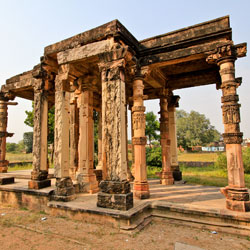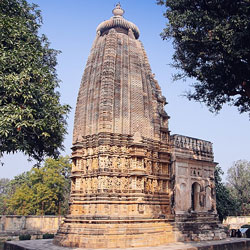
- Home
- Travel Packages
- Top Destination
-
Travel Attraction
By Category
Top Attraction

- Travel Agents
- Car Rentals
- Hotels

About Ghantai Temple, Khajuraho History The Ghantai Temple is located in Khajuraho, a UNESCO World Heritage Site known for its beautiful temples. The temple was built in the 10th century by the Chandela dynasty, dedicated to the Jain religion. It is named after the bells (ghanta) that adorn the outer walls of the temple. Architecture and Design The Ghantai Temple showcases intricate carvings and sculptures that depict various Jain deities and celestial beings. The temple's architecture follows the traditional Nagara style with a shikara (spire) and mandapa (pillared hall). The outer walls are adorned with images of tirthankaras (spiritual teachers) and scenes from Jain mythology. Best Time to Visit Visit during the winter months from October to March for pleasant weather. Avoid the monsoon season from July to September due to heavy rainfall. Plan your visit early in the morning or late in the evening to avoid the crowds. Cultural Significance The Ghantai Temple is an important pilgrimage site for Jains, attracting devotees from around the world. It symbolizes peace, harmony, and spiritual enlightenment, making it a sacred place for meditation and prayer. Pilgrimage Practices Visitors to the Ghantai Temple are encouraged to observe silence, respect the sanctity of the temple, and participate in rituals such as offering prayers and lighting incense. Pilgrims often perform parikrama (circumambulation) around the temple as a form of devotion. Dress Code and Etiquette Visitors are expected to dress modestly when visiting the Ghantai Temple, covering their shoulders and knees. Shoes are not allowed inside the temple premises, so it is recommended to wear comfortable footwear that can easily be removed before entering. Activities and Experiences Visitors can explore the intricate carvings and sculptures of the Ghantai Temple, learn about Jain mythology and teachings, and participate in meditation and prayer sessions. Guided tours are also available for those interested in learning more about the history and significance of the temple. Art and Religious Symbols The Ghantai Temple features stunning artwork that showcases the creativity and craftsmanship of the Chandela artisans. The temple's sculptures and carvings depict various Jain deities, symbols, and mythological stories, reflecting the spiritual beliefs and practices of the Jain community. Local Insights Local guides and historians can provide valuable insights into the history, architecture, and significance of the Ghantai Temple. They can share stories and anecdotes that offer a deeper understanding of the temple's cultural and religious significance, making your visit a truly enriching experience.
Explore More
About Adinath Temple, Khajuraho History The Adinath Temple in Khajuraho, India is a significant Jain temple that dates back to the 11th century. It was built during the Chandela dynasty and is dedicated to the Jain Tirthankara, Adinath. The temple complex is known for its intricate carvings and stunning architecture, which showcases the skill and craftsmanship of the artisans of that era. Architecture and Design The Adinath Temple is a fine example of Nagara style architecture, characterized by its tall spires. The temple is adorned with elaborate sculptures of Jain deities, celestial beings, and mythological creatures. The intricate carvings on the walls depict scenes from Jain mythology and everyday life. The temple's sanctum sanctorum houses the idol of Adinath, which is worshipped by devotees. Best Time to Visit - The best time to visit the Adinath Temple is during the winter months from November to February when the weather is pleasant. - It is recommended to visit early in the morning or late in the evening to avoid the heat of the day. - Plan your visit during the Khajuraho Dance Festival held in February, where you can witness traditional Indian dance performances against the backdrop of the illuminated temples. Cultural Significance The Adinath Temple holds immense cultural significance for the Jain community as a place of worship and pilgrimage. It is a symbol of Jain architecture and religious heritage, reflecting the values and beliefs of the Jain faith through its art and design. Pilgrimage Practices Devotees visiting the Adinath Temple engage in various religious practices such as offering prayers, performing rituals, and seeking blessings from the deity. Some pilgrims also undertake fasting and meditation as a form of spiritual discipline during their visit to the temple. Dress Code and Etiquette Visitors to the Adinath Temple are required to dress modestly and respectfully. It is advisable to wear appropriate attire that covers the shoulders and knees. Removing footwear before entering the temple premises is a common practice to show reverence to the sacred space. Silence and decorum are also expected inside the temple to maintain the sanctity of the place of worship. Activities and Experiences While at the Adinath Temple, visitors can participate in various activities such as attending religious ceremonies, exploring the temple complex, and admiring the intricate carvings and sculptures. Additionally, visitors can engage in meditation and prayer to experience a sense of spiritual tranquility in the serene ambiance of the temple. Art and Religious Symbols The Adinath Temple is adorned with exquisite artwork and religious symbols that depict Jain cosmology and spiritual philosophy. The intricate carvings on the temple walls showcase scenes from Jain mythology, the life of Adinath, and the principles of non-violence, truth, and compassion that are central to Jainism. Local Insights Local guides and historians can provide valuable insights into the history, architecture, and cultural significance of the Adinath Temple. They can offer a deeper understanding of the symbolism and significance of the sculptures and carvings, as well as share fascinating stories and anecdotes related to the temple and its place in Jain heritage.
Explore More5D - 4N Madhya Pradesh Tour Package
5 Days/ 4 Night
Bhopal - Indore - Ujjain - Sanchi
Ujjain - Mahakaaleshwar - Omkareshwar Jyotirlinga Tour Package
3 Days/ 2 Night
Indore
Madhya Pradesh Tour Package 5D - 4N
5 Days/ 4 Night
Bhopal - Indore - Ujjain - Sanchi
Mystic Khajuraho Getaway from Lucknow
3 Days/ 2 Night
Khajuraho